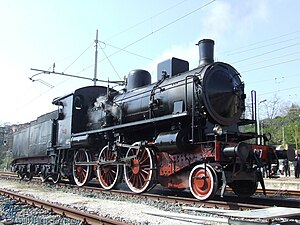This article needs additional citations for verification .(September 2015) |
| FS Class 625 | |||||||||||||||||||||||||||||||||||||||||||||
|---|---|---|---|---|---|---|---|---|---|---|---|---|---|---|---|---|---|---|---|---|---|---|---|---|---|---|---|---|---|---|---|---|---|---|---|---|---|---|---|---|---|---|---|---|---|
 Locomotive 625 017 | |||||||||||||||||||||||||||||||||||||||||||||
| |||||||||||||||||||||||||||||||||||||||||||||
| |||||||||||||||||||||||||||||||||||||||||||||
| |||||||||||||||||||||||||||||||||||||||||||||
The Ferrovie dello Stato (FS, Italian State Railways) Class 625 (Italian : Gruppo 625) is a class of 2-6-0 'mogul' steam locomotives in Italy. The class is commonly known by the nickname Signorine (Italian for 'young ladies', also shared with the similar Class 640 locomotives), [1] or Signorina in the singular, because of their perceived grace and beauty compared to other locomotives.
